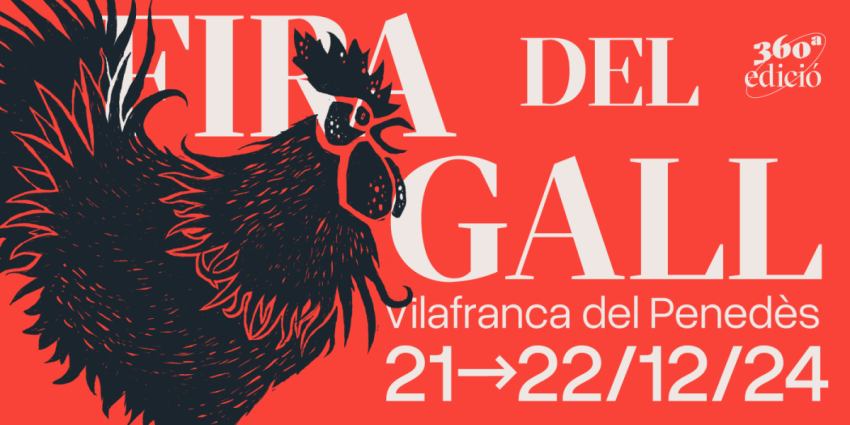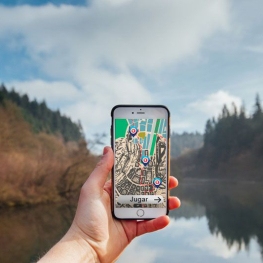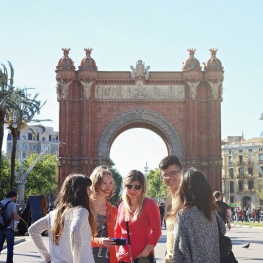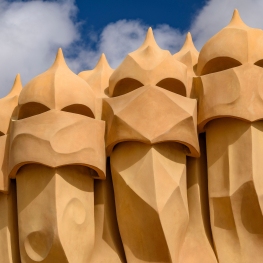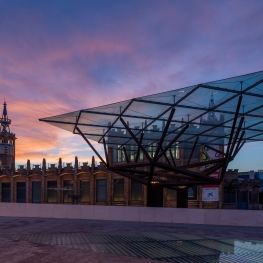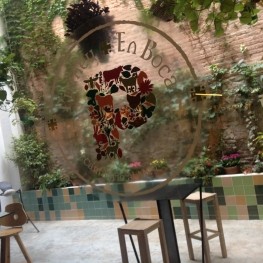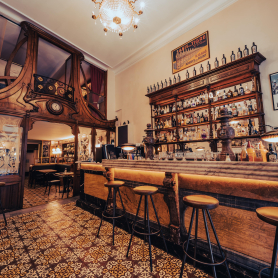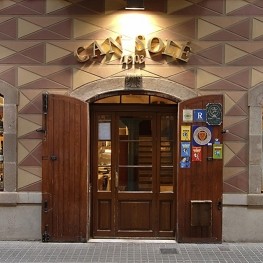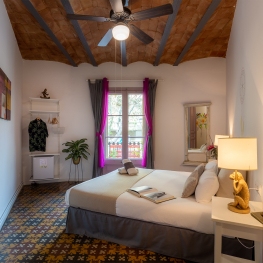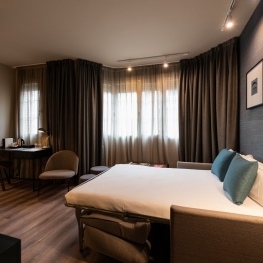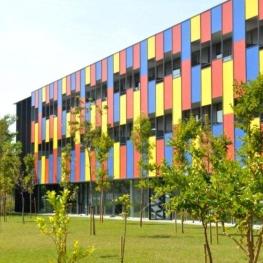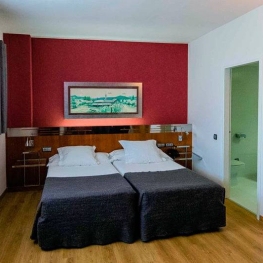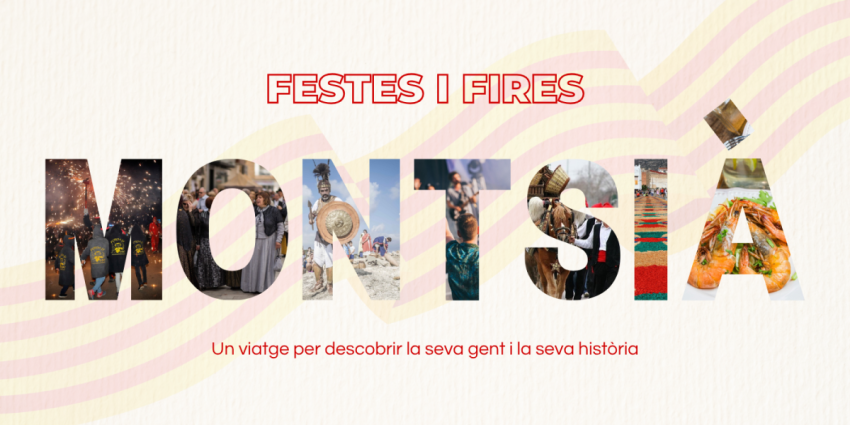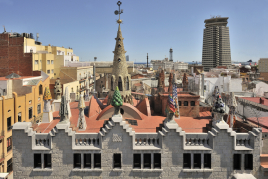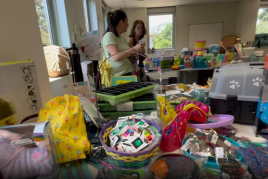The air raid shelters in Barcelona
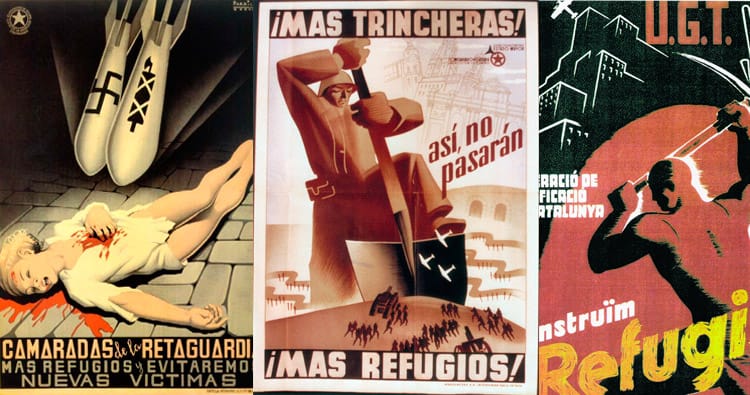
Now that is so fashionable debate about historical memory in Spain, is a good time to remember the Civil War and its impact on Barcelona.
From femturisme.cat we wanted to publish a route dedicated especially to bomb shelters were built in the old city, the visit of which leaves no one indifferent.
A little history
 Barcelona was the first city bombed systematically against civilians in a war during the Spanish Civil War by the German and Italian air armies. Some historians say that these bombings were one workout prior to the Second World War by the Nazi armies, but what is certainly true is that civil society and the authorities of the time had to mobilize against a danger which threatened them day night.
Barcelona was the first city bombed systematically against civilians in a war during the Spanish Civil War by the German and Italian air armies. Some historians say that these bombings were one workout prior to the Second World War by the Nazi armies, but what is certainly true is that civil society and the authorities of the time had to mobilize against a danger which threatened them day night.
The Generalitat de Catalunya, specifically from Passive Defence Board of the Government, commissioned Ramon Perera, an engineer of 31 years he was a member of the Board, to design a system that would allow people shelter from air attacks.
The solution Ramon Perera found most effective at the time, was under. They were building bomb shelters a few meters underground to which could be accessed via the staircase of a block of flats or from the street. But this model of refuge, was more than a shelter: it was Catalan vault construction with exposed brick to withstand the force of bombs and entries ziga-defense to protect themselves from the blast of shrapnel. A design of passive defense at the time was not convincing at all, because the noise of the bombs was that people would think that this would fall at any time. But the reality is that the community of engineers and architects currently qualifies as very advanced structures and the test time is its high effectiveness, since according to historians, so far there are no known fatalities within these buildings.
 The construction of shelters, about 1400 only in Barcelona , was conducted with the cooperation of the entire population, at the time, everyone felt architects built men, while women and children drew the rune abroad. Engineers from other countries like Cyril Helsby, were so impressed by these constructions that even some went to Barcelona to watch in person.
The construction of shelters, about 1400 only in Barcelona , was conducted with the cooperation of the entire population, at the time, everyone felt architects built men, while women and children drew the rune abroad. Engineers from other countries like Cyril Helsby, were so impressed by these constructions that even some went to Barcelona to watch in person.
After the Civil War, Perera could save part of the documentation of the Passive Defence Board, which was sent along with other files to Salamanca, and then, like many other Republicans, he went into exile. In Perpignan, the Red Cross provided him to write letters abroad and contacted Helsby, who helped him to flee to London without having any paper or documents, a privilege for an exile, but he had the solution to the protection of London citizens in World War burst.
 However, the British Conservative government opted moment at the end by the Anderson model, a kind of metal construction that was installed in the gardens of the houses, as opposed to Model Barcelona Perera, attacked as the government works for people gandula coward would become, a fact that has never happened in Barcelona . The result was catastrophic Anderson Model, since not all had garden to install it at home and it could do with some buildings were protecting from shrapnel but not bombs. Confidential reports of the period, that have come to light recently, recognize that the failure to have adopted the Model Barcelona, ??was a failure, because in London killed more than 40,000 people, eight times more than all the casualties during the Civil War throughout Catalonia.
However, the British Conservative government opted moment at the end by the Anderson model, a kind of metal construction that was installed in the gardens of the houses, as opposed to Model Barcelona Perera, attacked as the government works for people gandula coward would become, a fact that has never happened in Barcelona . The result was catastrophic Anderson Model, since not all had garden to install it at home and it could do with some buildings were protecting from shrapnel but not bombs. Confidential reports of the period, that have come to light recently, recognize that the failure to have adopted the Model Barcelona, ??was a failure, because in London killed more than 40,000 people, eight times more than all the casualties during the Civil War throughout Catalonia.
As a curiosity, note that Perera ended up working in the war industry, he, the man who had saved so many lives.
The shelter Poble Sec 307
 The Poble Sec 307 shelter is located at the foot of the mountain of Montjuïc and is one of the largest. The local residents tunnel dug 400 meters advised by architects. The shelter was lit by oil lamps and had a capacity for 2000 people sitting on wooden benches. The neighborhood was one of the hardest hit by aerial bombardment, to the point that a family had lost their home two or three times while I was sheltered underground, and in the end had to live in one of the city shelters.
The Poble Sec 307 shelter is located at the foot of the mountain of Montjuïc and is one of the largest. The local residents tunnel dug 400 meters advised by architects. The shelter was lit by oil lamps and had a capacity for 2000 people sitting on wooden benches. The neighborhood was one of the hardest hit by aerial bombardment, to the point that a family had lost their home two or three times while I was sheltered underground, and in the end had to live in one of the city shelters.
For years, the neighborhood mobilization, allowed the shelter did not fall into oblivion. Now, thanks to its restoration, everyone can see this important relic of the immediate past of our country.
Currently, the MUHBA Museu d'Historia de Barcelona manages the refuge and are guided tours for school children for weekdays and weekends particular. You have to be the case of the special activities organized by the Museum during different times of the year. The tour runs through the various rooms of the shelter-a fountain with a water tank, the kitchen, the pharmacy where healed the wounded to isolate them from other occupants of the shelter ... - and evokes the feelings of those who once were there locked-odor and wetness, the sound of raindrops, the sound of a siren and radio ... while explaining that people who took refuge there was really dramatic conditions as they probably had relatives out and while they were underground were totally uninformed about what was happening on the street and then when they found out was full of wounded and dead.
The refuge Diamond Square
 In the district of Gracia, where about ninety shelters were built, we find the famous Plaza del Diamante. This refuge was rediscovered in 1992 by the construction of a power station and a historian who had evidence of their existence and, after various recovery efforts, was reopened to the public in 2006. Humidity and temperature have allowed this shelter is one of the most well preserved.
In the district of Gracia, where about ninety shelters were built, we find the famous Plaza del Diamante. This refuge was rediscovered in 1992 by the construction of a power station and a historian who had evidence of their existence and, after various recovery efforts, was reopened to the public in 2006. Humidity and temperature have allowed this shelter is one of the most well preserved.
With a capacity for 200 people and sunk 12 meters underground, there are about 250 meters from narrow tunnels that run underground from the square and Guilleries Street. The walls and ceiling are made ??of bricks and you can still see the health of the shelter Joanic Square, the stone benches, nursing and even brands of candle smoke that neighbors brought to light as they entered the shelter after to hear the siren of a nearby factories warned them of impending bombing.
During the visits, visitors are actively involved, and they play the role of people who hid in the shelters. You need to arrange a visit.
The refuge of the Plaza of the Revolution
 In the same vila de Gracia find another shelter, less important and in worse shape than before. From the square, particularly from the fourth floor of the parking, accessed by a small door is not always open. There are sporadic visits driven by the Gracia district.
In the same vila de Gracia find another shelter, less important and in worse shape than before. From the square, particularly from the fourth floor of the parking, accessed by a small door is not always open. There are sporadic visits driven by the Gracia district.
In this case, the shelter was exposed to do the works of the remodeling of the plaza.
You can visit a part of what was at the time. The shelter is well lit, but the smell and moisture that there are quite strong.
What you can see is only a small part of the old shelter formed by a gallery and two nursing rooms at the entrance of which you can still see the inscription "CURES". Originally occupied the entire square, at a depth of about 11 meters, with three passageways and three galleries that had electrical wiring. The amplitude of the passages between 1.6 and 2 meters and unlike the other two shelters, the walls were lined with shelves to place plaster drugs and medical devices. The benches against the wall can still be seen. The ceiling in turn, is secured by a system of steel beams.
The refuge les Heures Palace
 This shelter has an excellent state of preservation and even electrical installation intact, adapted to modern times. However, your visit is subject to the acceptance of the request of the visitors by the University of Barcelona and the Barcelona Provincial Council (owner of the Palacio de les Heures).
This shelter has an excellent state of preservation and even electrical installation intact, adapted to modern times. However, your visit is subject to the acceptance of the request of the visitors by the University of Barcelona and the Barcelona Provincial Council (owner of the Palacio de les Heures).
This shelter has a special historical interest who claimed to be the President of the Government of the day, Lluís Companys, during the bombing of the city. The president had gone to live in this palace as it was located far from the strategic objectives pursued by Franco aviation.
Access is easy from a metal door located in the basement of the palace and down some stairs to a tunnel with a lap of concrete and brick walls about 40 meters long, about 1.15 meters in breadth and about 2, 15 meters high. The construction has a great consistency and quality technique also includes a ventilation shaft.
Other shelters
 There are many other shelters in Barcelona that can be visited, but the problem of cultural policy and private ownership have many of them prevent normally be open to the public. You can only access them if allege any ground such as research or audiovisual productions shooting.
There are many other shelters in Barcelona that can be visited, but the problem of cultural policy and private ownership have many of them prevent normally be open to the public. You can only access them if allege any ground such as research or audiovisual productions shooting.
It is also interesting to note that the absence of shelters throughout the population, many citizens also took advantage of the passages and subway and train to become makeshift shelters. University Square Station is a clear example of this dual use of the seasons.
How come?
307 Refuge:
- By subway: Parallel (L2 and L3)
- By Bus: urban lines 20, 21, 24, 36, 57, 64, 91, 121 and 157.
- In Funicular: Funicular de Montjuïc (Parallel stop)
Refuge Refuge Plaça del Diamant and Plaça de la Revolució:
- By subway: Fontana (L3)
- By Bus: urban lines 22, 24, 28, 39, 87, 92, 114 and 116.
- In FGC Gràcia stop
Refugio del Palau de les Heures:
- By subway: Mundet (L3)
- By bus: buses 10, 27, 60, 73 and 76 and, from Badalona, ??i B19 B16.
What to do
Gymkana Digital Turística
BarcelonaTourist and cultural routes in a gymkhana format. Completely free and without…
Gimcanes GeoCats
BarcelonaDiscover Barcelona with GeoCats in the most convenient and fun way possible!…
CaixaForum, Fundació La Caixa
Barcelona (a 2.8 Km)Discover CaixaForum, a fun way to connect with culture and science, and…
Where to eat
Restaurant Windsor
Barcelona (a 2.2 Km)The Windsor restaurant, located in Barcelona, is a benchmark of contemporary Catalan…
Bar Muy Buenas
BarcelonaFew words better define Muy Buenas than "coherence." Purely modernist decor, restored…
Where to sleep
Atenea Rekord Suites
Barcelona (a 3.5 Km)The Atenea Rekord Suites Barcelona is a boutique hotel with 15 modern…
Alberg Centre Esplai, Fundesplai
El Prat de Llobregat (a 11 Km)Discover the Centro Esplai hostel, in the municipality of El Prat de…
Aparhotel Atenea Barcelona
Barcelona (a 4.1 Km)The Aparhotel Atenea Barcelona, located in the heart of the Les Corts…

